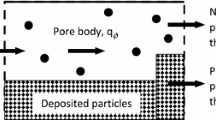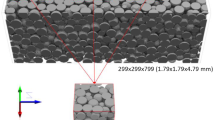Abstract
This article presents a practical transfer function type solution to a complex problem in which variations in a number of parameters can be taken into account. A new mathematical model, which is based on mass balance transfer function of particles movement/retention in porous media, has been derived. It is used to predict permeability reduction as a function of time. The linear forms as well as the radial forms of the model are described. Although the differential equations derived are similar to the general form of diffusion–convection equations, the marked difference is the suitability of the model, for being applied for variation of parameters, such as particle concentration in the fluid, injection rate, density of solid particles, against the depth and time of invasion. This transfer function has been solved, and the results of the simulation run agree reasonably well with the experimental damage data obtained in laboratory. Owing to its simplicity, this model is more practical to describe permeability reduction for the flow of suspended particles in porous media.
Similar content being viewed by others
Abbreviations
- A :
-
Area (m2)
- C :
-
Mass solid concentration (ppm)
- C d :
-
Constant
- K :
-
Permeability (m2)
- L :
-
Length (m)
- M :
-
Model parameter (s−1)
- m :
-
Mass of suspension particle (kg)
- p :
-
Pressure (N/m2)
- q :
-
Volumetric flow rate (m3/s)
- t :
-
Time (s)
- V :
-
Volume (m3)
- n :
-
Number of elements
- \({\phi }\) :
-
Porosity
- λ :
-
Trapping efficiency
- λ c :
-
Filtration coefficient
- λ 0 :
-
Initial filtration coefficient
- σ v :
-
The volume of particles deposited per unit volume of the bed
- ν :
-
Approach velocity
- μ 1 :
-
Viscosity of the carrier liquid (kg/m s)
- ρ :
-
Fluid density (kg/m3)
- τ :
-
Time constant
- o:
-
Core inlet, stagnant or initial
- b:
-
Bulk
- i :
-
Initial or inlet
- in:
-
Inlet
- out:
-
Outlet
- j :
-
Order of elements
References
Civan F., Kapp Roy M., Ohen Henry A.: Alteration of permeability of fine particle processes. J. Petrol. Sci. Eng. 3, 65–79 (1990)
Gruesbeck C., Collins R.E.: Entrainment and deposition of fine particles in porous media. Soc. Petrol. Eng. pap. 8430, 847–857 (1982)
Iwasaki T.: Some notes on sand filteration. J. Am. Water Works Assoc. 29, 1591 (1937)
Khilar, K.C., Fogler, H.S.: Water sensitivity of sandstones. SPEJ 55–64 (1983)
Khilar K.C., Fogler H.S.: Colloidally induced fines migration. Rev. Chem. Eng. 4, 41 (1987)
Kumar, T., Todd, A.C.: A new approach for mathematical modeling of formation damage due to invasion of solid suspensions. In: Paper SPE 18203 presented at the 63rd annual technical conference and exhibition of the society of petroleum engineers, Houston, TX, 2–5 Oct 1988
Rochon, J., Creusot, M.R., Rivet, P.: Water quality for water injection wells. In: Society of Petroleum Engineer 31122, Society of Petroleum Engineer Formation Damage Control Symposium, Lafayette, USA, 14–15 Feb 1996
Sharma M.M., Yortsos Y.C.: Transport of particulate suspensions in porous media: model formulation. AIChE J. 33, 1637 (1987)
Song L., Elimelech M.: Dynamics of colloid deposition in porous media: modeling the role of retained particles. Colloids Surf. A Physicochem. Eng. Asp. 73, 49–63 (1992)
Song L., Elimelech M.: Transient deposition of colloidal particles in heterogeneous porous media. J. Colloid Interface Sci. 167(2), 301–313 (1994)
Soo H., Radke Clayton J.: The flow mechanism of dilute stable emulsion in porous media. Ind. Eng. Chem. Fund. 23, 342–347 (1986)
Wojtanowicz, A.K., Krillov, Z., Langlinais, J.P.: Study of effect of pore blocking mechanisms on formation damage. In: Society of Petroleum Engineer paper 16233 presented at the Society of Petroleum Engineer Production Operations (1987)
Wojtanowicz A.K., Krillov Z., Langlinais J.P.: Experimental determination of formation damage pore Technol 110, 34–42 (1988)
Author information
Authors and Affiliations
Corresponding author
Rights and permissions
About this article
Cite this article
Dahaghi, A.K., Gholami, V. & Moghadasi, J. A Novel Workflow to Model Permeability Impairment through Particle Movement and Deposition in Porous Media. Transp Porous Med 86, 867–879 (2011). https://doi.org/10.1007/s11242-010-9658-9
Received:
Accepted:
Published:
Issue Date:
DOI: https://doi.org/10.1007/s11242-010-9658-9




